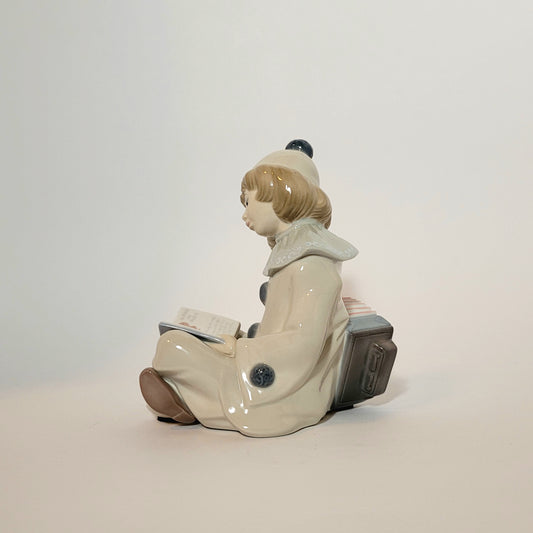
Lladro Porcelain Figurines
BACKGROUND
Lladró is a Spanish fine art brand that specializes in contemporary sculpture, home decor, lighting, and jewelry, and is particularly known for its exquisite porcelain figurines which have become easily recognizable amongst collectors.
EARLY DAYS
Born from the artistic drive, creativity, and passion of three brothers, Juan, José and Vicente Lladró, the company began in their home of Almàssera, a rural Spanish village with pottery deeply rooted in its culture. The three brothers grew up working on the family farm, but all showed great artistic promise after being enrolled in the San Carlos de Valencia School of Arts and Crafts by their mother. In 1953, the brothers made the bold decision to quit their day jobs, and with borrowed money from a friend, they founded Lladró Porcelain in a small workshop. They combined their various artistic talents, including painting and sculpting, to produce their own porcelain pieces, including vases, plates, and figurines. Due to overwhelming support from the public, the workshop required multiple expansions until they would eventually outgrow the space in 1958 and move into a warehouse.
1960s
By the 1960’s, Lladró began utilizing their innovative single-firing method, which quickly replaced the traditional triple-firing method. This revolutionary method allowed the brothers to achieve the beautiful pastel tones the brand has since become known for. In 1962, the brothers founded the Professional Training School at Lladró’s headquarters in Valencia in order to share their artistic vision as well as their experience and knowledge of working with porcelain. This school also provided the company with a surplus of talented and newly-qualified artists, chemists, technicians, and decorators, which allowed them to increase their production and visibility to new potential markets. By 1965, Lladró entered the US market and was enthusiastically embraced by American consumers. In 1969, the Lladró museum known as The City of Porcelain opened its doors, which includes a large exhibition showcasing Lladró's history, as well as a store, allowing customers to purchase current productions. The museum even offers guided tours of the production factory, which has given the public the opportunity to meet the artists and witness the complete process behind the creation of a figurine. The City of Porcelain is still open to the public to this day and is now the only source of new Lladró pieces, exporting to over 120 countries around worldwide.
1970s
The 70s are considered to be a period of creative maturation for the company as, after much research, Lladró began utilizing a new material called gres, which is more resistant than porcelain, and is characterized by its earthy tones. The use of gres not only increased the creative resources available to Lladró's team of artists, it also allowed for wider creative expression. The exquisite quality of the pieces that were produced allowed the artists to be more ambitious with their creations as well. At this time, Lladró began making limited series and quickly began receiving recognition on a global scale. Over the course of the decade, the pieces produced by Lladró artists continued to develop into a style that is both softly elegant yet deeply touching. Their wide varieties of figurines are often characterized by the romanticism of human emotion and has become a style which Lladró is now internationally recognized for.
1980s
After over 15 years of Lladró's existence, the Lladró Collectors' Society was officially founded in 1985, with more than 100,000 members sharing their love and enthusiasm for their collections. The 1980s were also marked as a period of great expansion for the company as they opened subsidiaries in Japan and China in 1986, as well as its first gallery and museum in New York City, on Fifth Avenue in Manhattan in 1988. After 30 years from the birth of the company, it was time to decide who would take over responsibility to ensure the company's future. In 1984, one child from each of the three brothers was admitted into leadership roles after completing apprenticeships in a variety of roles within the company. Lladró continued to expand globally through the late eighties, opening more subsidiaries in the US and Australia, and even creating Lladro Centers to exhibit their exquisite porcelain works in major cities worldwide.
1990s
By the early nineties, the complexities of Lladró pieces continued to evolve as the artists began producing highly detailed scenes involving multiple figures as well as beautiful, intricate floral compositions, which showcased the meticulous attention to detail achieved by the artists’ skill. In 1995 Lladró opened its first boutique in the fashion district of Ginza in Tokyo, shortly followed by its first store in Madrid, as well as a Beverly Hills boutique on Rodeo Drive in 1997.
2000s-2010s
In 2003, half a century after the company was founded, the three brothers gave full control of the company to the second generation. The Lladró family only maintained control of the company until 2004 but they continue to work closely with the current CEO to ensure that the pieces being produced today still align with the Lladró standard. Also taking place in the aughts was Lladró's reinvention of itself with pieces sculpted either in matte white porcelain or bold, decorative pieces in vivid colors. In the 2010s, Lladró began collaborating more frequently with world-renowned artists and designers including Paul Smith, Rolito, and Gary Baseman. In 2012, the Lladró Boutique opened at 500 Madison Avenue in New York City.
TODAY
The Lladró of today has expanded well beyond the intricate and endearing porcelain figures the brand became known for decades ago and now offers a variety of more functional product lines such as Light & Scent, which features home scents, wireless lamps and large lighting collections, as well as tableware, centerpieces, and jewelry, among many other offerings. Though the Lladró family no longer maintains full control of the company, one thing that has remained the same is the artistry behind the designs and an eco-friendly approach to creating with porcelain, a living material which Lladró has proven offers infinite possibilities.






